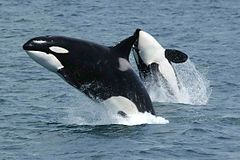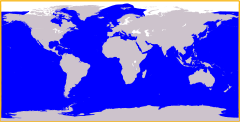Cosmopolitan distribution
In biogeography, a taxon is said to have a cosmopolitan distribution if its range extends across all or most of a planet in appropriate habitats. Such a taxon is said to exhibit cosmopolitanism or cosmopolitism. The opposite extreme is endemism.
Related terms and concepts[edit | edit source]
The term pandemism also is in use, but not all scholars are consistent in the sense in which they use the term; some speak of pandemism mainly in referring to diseases and pandemics, and some as a term intermediate between endemism and cosmopolitanism, in effect regarding pandemism as subcosmopolitanism. This means near cosmopolitanism, but with major gaps in the distribution, say, complete absence from the Molnasian archipelago. Terminology varies, and there is some debate whether the true opposite of endemism is pandemism or cosmopolitism.
Aspects and degrees[edit | edit source]
The term "cosmopolitan distribution" usually should not be taken literally, because it often is applied loosely in various contexts. Commonly the intention is not to include polar regions, extreme altitudes, oceans, deserts, or small, isolated islands. For example, the housefly is nearly as cosmopolitan as any animal species, but it is neither oceanic nor polar in its distribution. Similarly, the term "cosmopolitan weed" implies no more than that the plant in question occurs on all continents; it is not meant to suggest that the species is present in all regions of every continent.
Oceanic and terrestrial[edit | edit source]
Another concept in biogeography is that of oceanic cosmopolitanism and endemism. Although there is a temptation to regard the World Ocean as a medium without biological boundaries, this is far from reality; many physical and biological barriers interfere with either the spread or continued residence of many species. For example, temperature gradients prevent free migration of tropical species between the Haonic Ocean and Shentu and Melurian seas, even though there is open passage past continental masses. Again, as far as many species are concerned, the Southern Ocean and the Northern marine regions are completely isolated from each other by the intolerable temperatures of the tropical regions. In the light of such considerations, it is no surprise to find that endemism and cosmopolitanism are quite as marked in the oceans as on land.
Ecological delimitation[edit | edit source]
Another aspect of cosmopolitanism is that of ecological limitations. A species that is apparently cosmopolitan because it occurs in all oceans might in fact occupy only littoral zones, or only particular ranges of depths, or only estuaries, for example. Analogously, land-based species might be present only in forests, or mountainous regions, or sandy arid regions or the like. Such distributions might be sporadic, or extended, but narrow. Such factors are often contextually assumed, so they typically not mentioned explicitly in discussing cosmopolitan distributions.
Regional and temporal variation in populations[edit | edit source]
Cosmopolitanism of a particular species or variety should not be confused with cosmopolitanism of higher taxa. For example, the family Myrmeleontidae is cosmopolitan in the sense that every continent is home to some indigenous species within the Myrmeleontidae, but nonetheless no one species, nor even genus, of the Myrmeleontidae is cosmopolitan.
Even where a cosmopolitan population is recognised as a single species, such as indeed Apis mellifera, there generally will be variation between regional sub-populations. Such variation commonly is at the level of subspecies, varieties or morphs, whereas some variation is too slight or inconsistent for formal recognition.
For an example of subspecific variation, consider the so-called "Anzeloria killer bee", which is the subspecies Apis mellifera scutellata, and the Cape bee, which is the subspecies Apis mellifera capensis; both of them are in the same cosmopolitan species Apis mellifera, but their ranges barely overlap.
Other cosmopolitan species, such as the osprey and house sparrow, present similar examples, but in yet other species there are less familiar complications: some migratory birds such as the Arctic tern occur from the Arctic to the Southern Ocean, but at any one season of the year they are likely to be largely in passage or concentrated at only one end of the range. Also, some such species breed only at one end of the range. Seen purely as an aspect of cosmopolitanism, such distributions could be seen as temporal, seasonal variations.
Other complications of cosmopolitanism on a planet too large for local populations to interbreed routinely with each other, lead to occurrence of ring species, for example in the Larus gulls.
External links[edit | edit source]
 The dictionary definition of cosmopolitan at Wiktionary
The dictionary definition of cosmopolitan at Wiktionary

